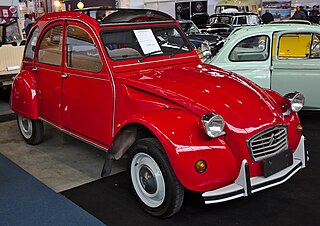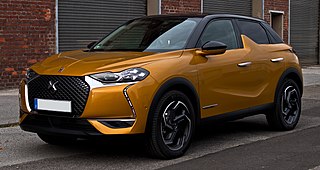
The Citroën 2CV is an economy car produced by the French company Citroën from 1948 to 1990. Introduced at the 1948 Paris Salon de l'Automobile, it has an air-cooled engine that is mounted in the front and drives the front wheels.

The Citroën Visa is a five-door, front-engine, front wheel drive supermini manufactured and marketed by Citroën from 1978 to 1988 in gasoline and diesel variants. 1,254,390 examples were ultimately manufactured over a single generation, with a single facelift (1981). China has also assembled the car as the Liuzhou Wuling LZW 7100 minicar. Production started in 1991 and finished in 1994.

The Citroën LN (Hélène) and Citroën LNA (Hélèna) are front-engine, front-drive, three-door, four passenger hatchback city cars manufactured and marketed by Citroën from 1976–1986 over a single generation — as a badge engineered variant of the Peugeot 104, introduced shortly after the takeover of Citroen by Peugeot.

The Renault 4, or R4 in short, is an economy car built by the French company Renault from 1961 to 1994. Although the Renault 4 was first marketed as a short estate or wagon, its minimal rear overhang, and its top-hinged, single-piece tail-gate made it the world's first mass-produced hatchback car, as well as the first time Renault had used a front-wheel-drive layout in a family car. A bare-bones, entry-level Renault 3, or R3 was also offered in 1961/1962.

The Nissan Micra, also known as the Nissan March, is a supermini car (B-segment) that has been produced by the Japanese automobile manufacturer Nissan since 1982.

The Citroën Ami is a four-door, front-wheel drive economy (B-segment) family car, manufactured and marketed by Citroën from 1961 to 1978.

The Chrysler PT Cruiser is a compact car that was built by the American company Chrysler from 2001 until 2010. Introduced as a five-door hatchback wagon, a two-door convertible variant was also made from 2005 until 2008.

The Citroën C1 is a city car marketed by Citroën from June 2005 to January 2022, originally developed as part of the B-Zero project by PSA Peugeot Citroën in a joint venture with Toyota, with two generations produced.

The Citroën Méhari is a lightweight recreational and utility vehicle, manufactured and marketed by French carmaker Citroën over 18 years in a single generation. Built in front-wheel (1968–1988) and four-wheel drive (1980–1983) variants, it features ABS plastic bodywork with optional/removable doors and foldable, stowable, fabric convertible top.

The Nissan Cube is a mini MPV produced by carmaker Nissan between 1998 and 2019. Initially sold only in Japan, the Cube was sold in North American markets from 2009 to 2014, and in European markets from 2009 to 2011. In Japan, it was exclusive to Nissan Red Stage dealerships. It is a slightly larger load-carrying alternative to the Nissan Micra hatchback. While production for the North American market ended in 2014, the Japanese-market Cube lasted until December 2019.

A cabrio coach or semi-convertible is a type of car that has a retractable textile roof, similar to a convertible/cabriolet. The difference is that where a convertible often has the B-pillar, C-pillar and other bodywork removed, the cabrio coach retains all bodywork to the top of the door frames and just replaces the roof skin and rear window with a retractable fabric panel.
A glossary of terms relating to automotive design.

The Nissan Be-1 is a retro-styled two-door notchback sedan manufactured by Nissan for model years 1987-1988, and originally marketed solely in Japan at their Nissan Cherry Stores.

The Nissan Pao is a retro-styled three-door hatchback manufactured by Nissan for model years 1989–1991, and originally marketed solely in Japan at their Nissan Cherry Stores.

The Nissan S-Cargo is a small retro-styled van manufactured by the Japanese automaker Nissan from 1989 to 1991, and originally marketed solely in Japan at their Nissan Cherry Stores.

The Mitsuoka Galue is a series of luxury cars, based on mainstream Japanese automobiles, customized by Mitsuoka to resemble classic British and American cars.

The DS 3 is a luxury supermini initially produced by the French automobile manufacturer Citroën and officially launched in January 2010. Positioned below the DS 4, this was the first and entry-level model from the DS premium sub-brand, which was spun-off in 2016 into DS Automobiles.

The eleventh generation of the Ford Thunderbird is a two-seat convertible manufactured and marketed by Ford from 2001 to 2005 for model years 2002 through 2005. It followed a five-year hiatus of the Thunderbird after the 1997 discontinuation of its tenth generation.

The Nissan Silvia is the series of small sports cars produced by Nissan. Versions of the Silvia have been marketed as the 200SX or 240SX for export, with some export versions being sold under the Datsun brand.
A retro-style automobile is a vehicle that is styled to appear like cars from previous decades. Often these cars use modern technology and production techniques. This design trend developed in the early 1990s and led to almost all automobile brands introducing models that referenced previous cars of the 1950s and 1960s.




















